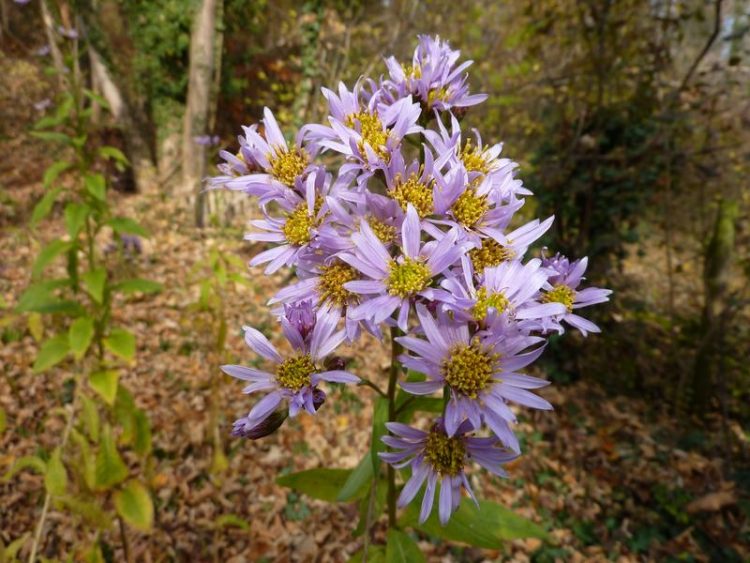Fungus produces active agent in a medicinal herb

Tatarinow's aster (Aster tataricus) contains the drug astin only if it contains the fungus which makes it, C. asteris. Photo: Christiane Henno
Tatarinow's aster is used in traditional Chinese medicine to treat a number of ailments; the plant contains an active ingredient known as astin – and it is this agent which cancer researchers are now investigating. However, the plant does not produce the astins itself, as was assumed for a long time; instead, they are made by a fungus that lives in the tissue of the flowers.
The discovery was made by an international team including Dr. Thomas Schafhauser and Professor Wolfgang Wohlleben from the University of Tübingen, and Dr. Linda Jahn, Professor Jutta Ludwig-Müller and Professor Karl-Heinz van Pée of the Technische Universität Dresden.
The researchers were successful in isolating the fungus, Cyanodermella asteris, and in cultivating it independently of the host plant. They have therefore laid the foundations for large-scale biotechnological production of astins. The study has been published in the latest Proceedings of the National Academy of Sciences.
Collecting medicinal plants from the wild may endanger their survival. Even if plants are cultivated for the production of natural substances, difficulties arise: plant growth is comparatively slow; the substances are often only produced in small quantities and have to be extracted from the plant in complex processes.
“The goal is therefore often cost-effective biotechnological production, as is the case here with astins,” says Thomas Schafhauser. Astins bind to an important human regulatory protein; this may allow them to be used to suppress immune responses and to combat tumor growth.
“In order to develop a biotechnological process, we need to know which genes are involved and the metabolic pathway leading to production of the required substance,” says Schafhauser. “Astins have an unusually complex chemical structure. Comparisons with similar substances indicate that bacteria or fungi make astins.”
The researchers discovered the fungus C. asteris living in the plant. In the researchers’ experiments, the fungus was easy to propagate and cultivate outside the plant. It also produced large amounts of astin. “In addition, we fully sequenced the fungal genome,” Schafhauser says. In the decoded genome, the team found the genes that are responsible for the synthesis of the astin molecule. This is an important requirement for the development of biotechnological methods for the commercial production of astin.
Cooperation between different species
In experiments, the researchers proved that individuals of the Aster tataricus did not produce astin unless the fungus C. asteris was present. The function could be restored by re-infection with the fungus. “Furthermore, these plants contained the variant astin A, which the fungus could not produce when cultivated individually,” Linda Jahn reports.
“We assume that the fungus and the plant work together to their mutual advantage in symbiosis, and that the plant gives a signal for the production of astin A or processes the astin from the fungus itself.”
Such metabolic pathways, which require symbiosis between two or more biological partners, have so far been largely unexplored. “It may be that they are very common, but we do not know enough about them,” says Jahn. In the case of Tatarinow's aster, it is unclear to what extent the complex substance astin provides an advantage. It could play a role in fending off predators or pathogens.
Dr. Thomas Schafhauser
University of Tübingen
Interfaculty Institute of Microbiology and Infection Medicine
Microbiology/Biotechnology
Phone +49 7071 29-74624
thomas.schafhauser[at]biotech.uni-tuebingen.de
Professor Dr. Jutta Ludwig-Müller
TU Dresden
Institute of Botany
Phone +49 351 463 33939
Jutta.Ludwig-Mueller[at]tu-dresden.de
Thomas Schafhauser, Linda Jahn, Norbert Kirchner, Andreas Kulik, Liane Flor, Alexander Lang, Thibault Caradec, David P Fewer, Kaarina Sivonen, Willem JH van Berkel, Philippe Jacques, Tilmann Weber, Harald Gross, Karl-Heinz van Pée, Wolfgang Wohlleben and Jutta Ludwig-Müller: Antitumor astins originate from the fungal endophyte Cyanodermella asteris living within the medicinal plant Aster tataricus. Proceedings of the National Academy of Sciences, week of December 2, 2019.
Media Contact
More Information:
https://uni-tuebingen.deAll latest news from the category: Life Sciences and Chemistry
Articles and reports from the Life Sciences and chemistry area deal with applied and basic research into modern biology, chemistry and human medicine.
Valuable information can be found on a range of life sciences fields including bacteriology, biochemistry, bionics, bioinformatics, biophysics, biotechnology, genetics, geobotany, human biology, marine biology, microbiology, molecular biology, cellular biology, zoology, bioinorganic chemistry, microchemistry and environmental chemistry.
Newest articles

NASA: Mystery of life’s handedness deepens
The mystery of why life uses molecules with specific orientations has deepened with a NASA-funded discovery that RNA — a key molecule thought to have potentially held the instructions for…

What are the effects of historic lithium mining on water quality?
Study reveals low levels of common contaminants but high levels of other elements in waters associated with an abandoned lithium mine. Lithium ore and mining waste from a historic lithium…

Quantum-inspired design boosts efficiency of heat-to-electricity conversion
Rice engineers take unconventional route to improving thermophotovoltaic systems. Researchers at Rice University have found a new way to improve a key element of thermophotovoltaic (TPV) systems, which convert heat…



